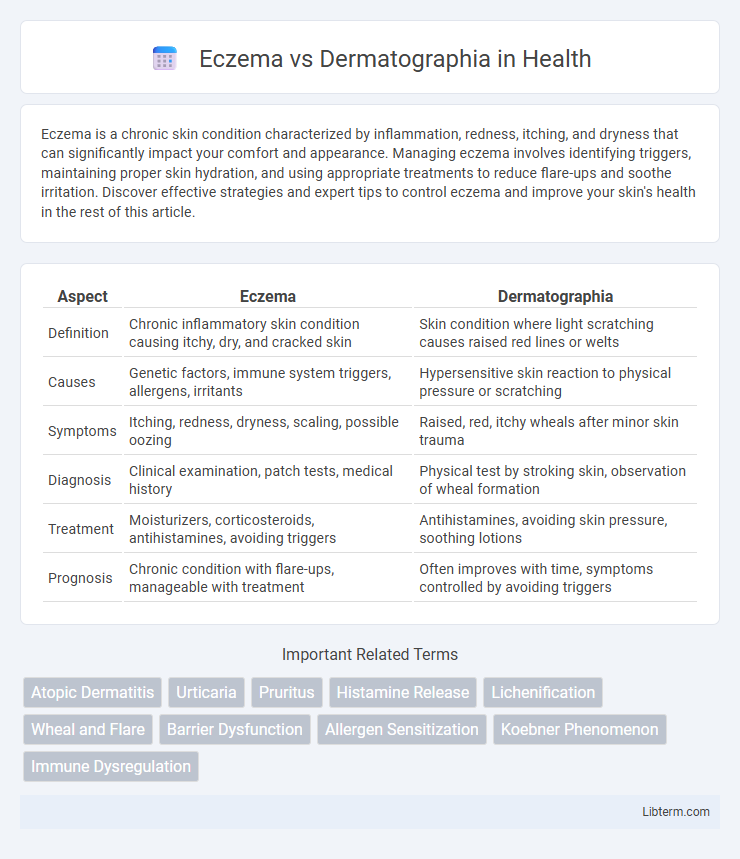Eczema is a chronic skin condition characterized by inflammation, redness, itching, and dryness that can significantly impact your comfort and appearance. Managing eczema involves identifying triggers, maintaining proper skin hydration, and using appropriate treatments to reduce flare-ups and soothe irritation. Discover effective strategies and expert tips to control eczema and improve your skin's health in the rest of this article.
Table of Comparison
| Aspect | Eczema | Dermatographia |
|---|---|---|
| Definition | Chronic inflammatory skin condition causing itchy, dry, and cracked skin | Skin condition where light scratching causes raised red lines or welts |
| Causes | Genetic factors, immune system triggers, allergens, irritants | Hypersensitive skin reaction to physical pressure or scratching |
| Symptoms | Itching, redness, dryness, scaling, possible oozing | Raised, red, itchy wheals after minor skin trauma |
| Diagnosis | Clinical examination, patch tests, medical history | Physical test by stroking skin, observation of wheal formation |
| Treatment | Moisturizers, corticosteroids, antihistamines, avoiding triggers | Antihistamines, avoiding skin pressure, soothing lotions |
| Prognosis | Chronic condition with flare-ups, manageable with treatment | Often improves with time, symptoms controlled by avoiding triggers |
Understanding Eczema: Causes and Symptoms
Eczema, also known as atopic dermatitis, is a chronic inflammatory skin condition caused by a combination of genetic and environmental factors, leading to a compromised skin barrier and immune response. Common symptoms include intense itching, red and dry patches, swelling, and sometimes oozing or crusting, with flare-ups triggered by allergens, irritants, or stress. Understanding eczema's underlying immune dysregulation helps distinguish it from dermatographia, which is characterized primarily by skin swelling and redness triggered by physical pressure or scratching.
What is Dermatographia? An Overview
Dermatographia, also known as skin writing, is a condition where minor skin scratches cause raised, red lines or welts, resembling hives. It is a form of physical urticaria triggered by mechanical pressure or scratching, causing histamine release in the skin. Unlike eczema, which involves chronic inflammation and dry, itchy patches, dermatographia primarily results in transient, visible skin reactions without persistent dryness or scaling.
Differences in Triggers: Eczema vs Dermatographia
Eczema triggers commonly include allergens such as pollen, pet dander, and harsh soaps, as well as environmental factors like dry air and stress, which provoke inflammatory skin reactions. Dermatographia triggers primarily involve physical stimuli such as scratching, pressure, or friction, leading to raised, red wheals on the skin due to hypersensitive mast cells. Understanding these distinct trigger mechanisms is crucial for accurate diagnosis and targeted treatment strategies in managing eczema and dermatographia effectively.
Key Symptoms: How to Tell Them Apart
Eczema typically presents with dry, itchy, inflamed patches of skin that may crack or ooze, often triggered by allergens or irritants. Dermatographia is characterized by raised, red welts or hives that appear within minutes after the skin is scratched or rubbed, usually fading within 30 minutes to an hour. Distinguishing between the persistent inflammation of eczema and the transient, inducible welts of dermatographia is crucial for accurate diagnosis and treatment.
Diagnosis: Identifying Eczema and Dermatographia
Diagnosing eczema involves identifying red, inflamed patches of skin often accompanied by itching and dryness, with a history of flare-ups linked to allergens or irritants. Dermatographia is diagnosed through a physical test where light scratching causes raised, red welts or hives that appear within minutes and fade within 30 minutes. Medical professionals use patient history, skin appearance, and response to stimuli to differentiate between these two common skin conditions effectively.
Common Treatment Options for Eczema
Topical corticosteroids are commonly prescribed to reduce inflammation and itching in eczema patients, while emollients help restore the skin's moisture barrier, preventing dryness and flare-ups. Antihistamines may be recommended to alleviate itching, and wet wrap therapy can soothe severe cases by enhancing skin hydration and allowing better absorption of medications. Avoiding triggers and maintaining a regular skincare routine are essential for effective eczema management and reducing symptom recurrence.
Managing Dermatographia: Best Practices
Managing dermatographia centers on minimizing skin irritation by avoiding tight clothing, rough fabrics, and excessive scratching. Applying hypoallergenic moisturizers and antihistamines helps reduce inflammation and control itchiness. Regular skin care routines with gentle cleansers and maintaining a cool environment can prevent flare-ups and improve overall comfort.
Preventive Measures for Both Conditions
Eczema prevention involves maintaining skin hydration with fragrance-free moisturizers, avoiding known irritants such as harsh soaps and allergens, and managing stress to reduce flare-ups. Dermatographia prevention focuses on minimizing physical skin trauma by avoiding scratching or aggressive rubbing, wearing soft, breathable fabrics, and using antihistamines as advised to control histamine response. Both conditions benefit from consistent skincare routines and environmental controls to reduce triggers and maintain skin barrier integrity.
When to See a Dermatologist
Seek a dermatologist if eczema symptoms worsen with persistent redness, scaling, and intense itching unresponsive to over-the-counter treatments. For dermatographia, medical consultation is crucial when raised, red welts appear after minor skin pressure or scratching, causing discomfort or spreading. Early diagnosis by a specialist ensures tailored treatments and prevents complications for both conditions.
Living with Eczema or Dermatographia: Lifestyle Tips
Managing eczema or dermatographia involves maintaining optimal skin hydration using fragrance-free moisturizers and avoiding known irritants like harsh soaps or tight clothing. Daily routines should include gentle cleansing, applying prescribed topical treatments promptly, and protecting skin from excessive heat or scratching to minimize flare-ups. Incorporating stress-reduction techniques such as mindfulness or light exercise can further improve skin health and reduce symptom severity.
Eczema Infographic

 libterm.com
libterm.com